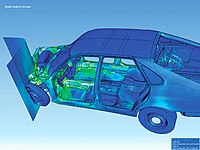
Photo from wikipedia
We present a novel isogeometric method, namely the Immersed Boundary-Conformal Method (IBCM), that features a layer of discretization conformal to the boundary while employing a simple background mesh for the… Click to show full abstract
We present a novel isogeometric method, namely the Immersed Boundary-Conformal Method (IBCM), that features a layer of discretization conformal to the boundary while employing a simple background mesh for the remaining domain. In this manner, we leverage the geometric flexibility of the immersed boundary method with the advantages of a conformal discretization, such as intuitive control of mesh resolution around the boundary, higher accuracy per degree of freedom, automatic satisfaction of interface kinematic conditions, and the ability to strongly impose Dirichlet boundary conditions. In the proposed method, starting with a boundary representation of a geometric model, we extrude it to obtain a corresponding conformal layer. Next, a given background B-spline mesh is cut with the conformal layer, leading to two disconnected regions: an exterior region and an interior region. Depending on the problem of interest, one of the two regions is selected to be coupled with the conformal layer through Nitsche’s method. Such a construction involves Boolean operations such as difference and union, which therefore require proper stabilization to deal with arbitrarily cut elements. In this regard, we follow our precedent work called the minimal stabilization method (Antolin et al in SIAM J Sci Comput 43(1):A330–A354, 2021). In the end, we solve several 2D benchmark problems to demonstrate improved accuracy and expected convergence with IBCM. Two applications that involve complex geometries are also studied to show the potential of IBCM, including a spanner model and a fiber-reinforced composite model. Moreover, we demonstrate the effectiveness of IBCM in an application that exhibits boundary-layer phenomena.
Journal Title: Computational Mechanics
Year Published: 2021
Link to full text (if available)
Share on Social Media: Sign Up to like & get
recommendations!